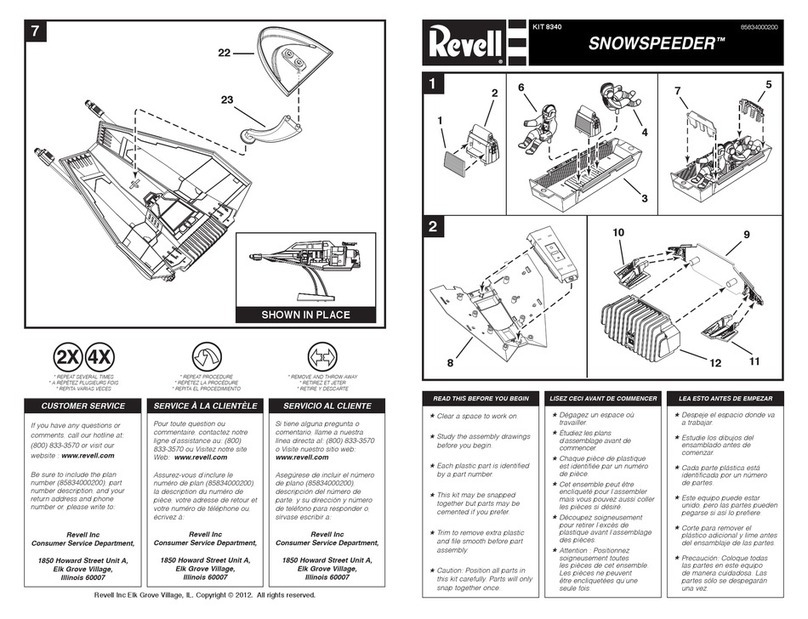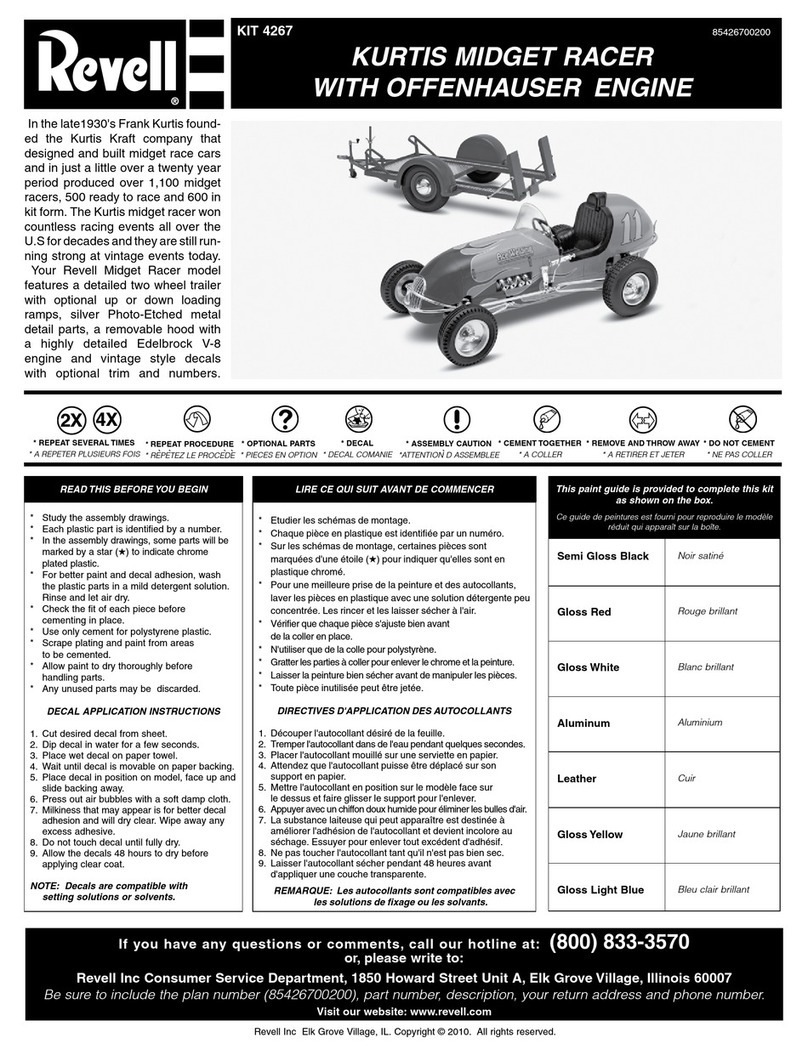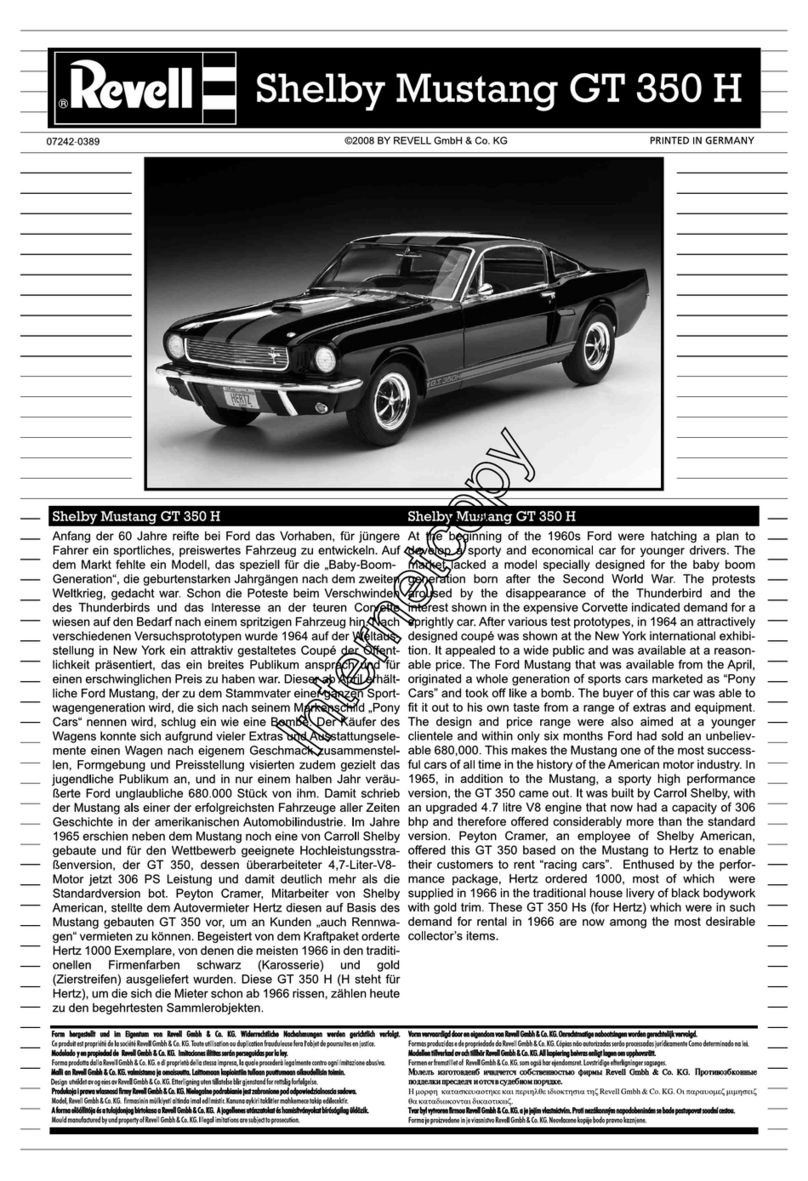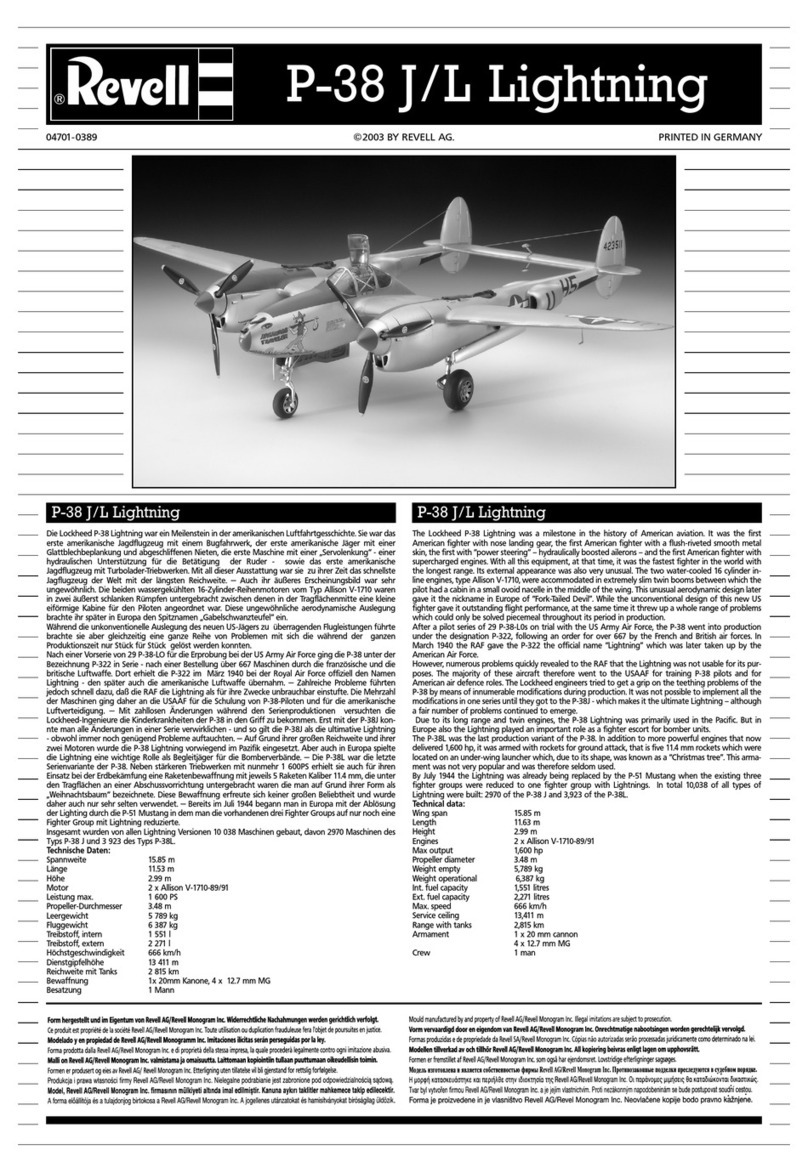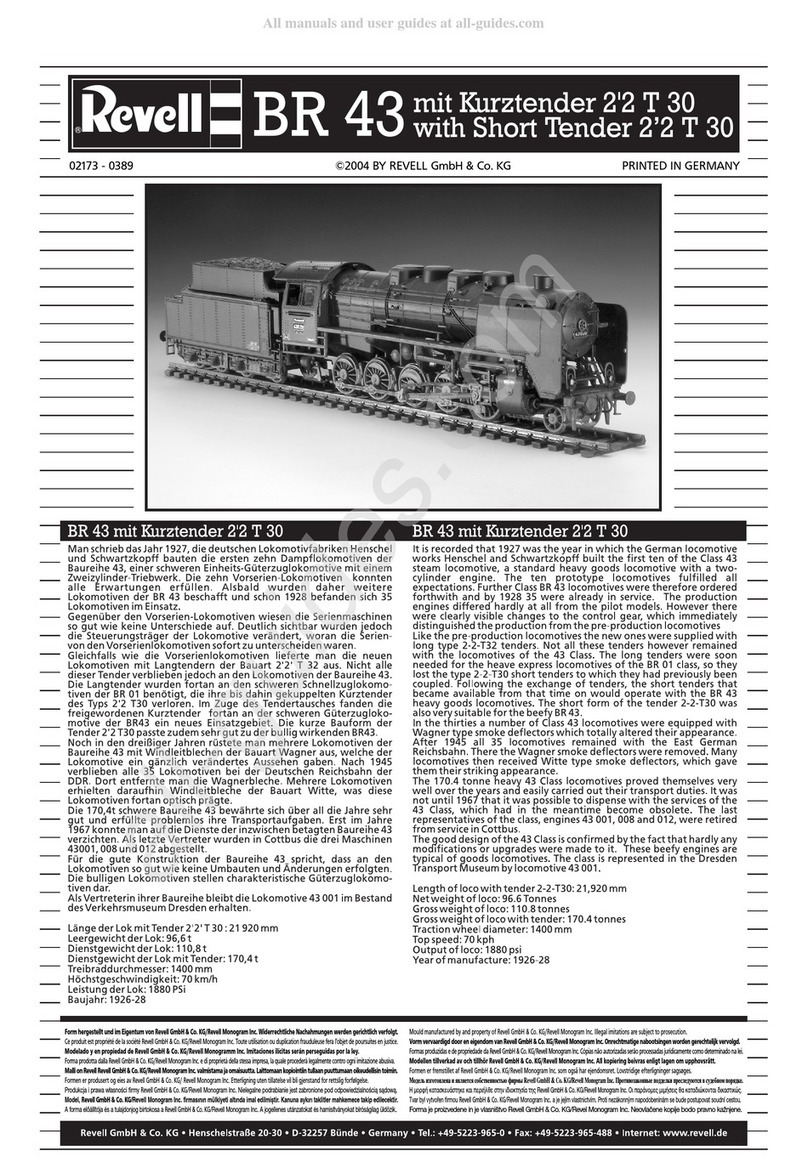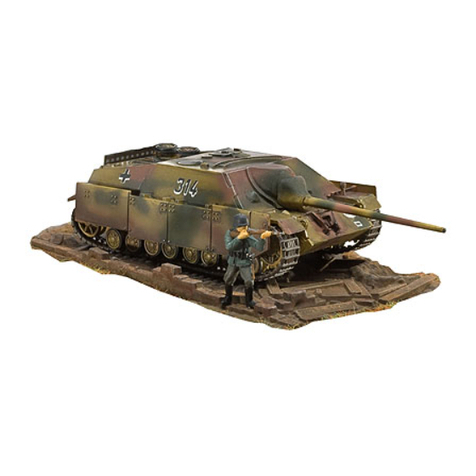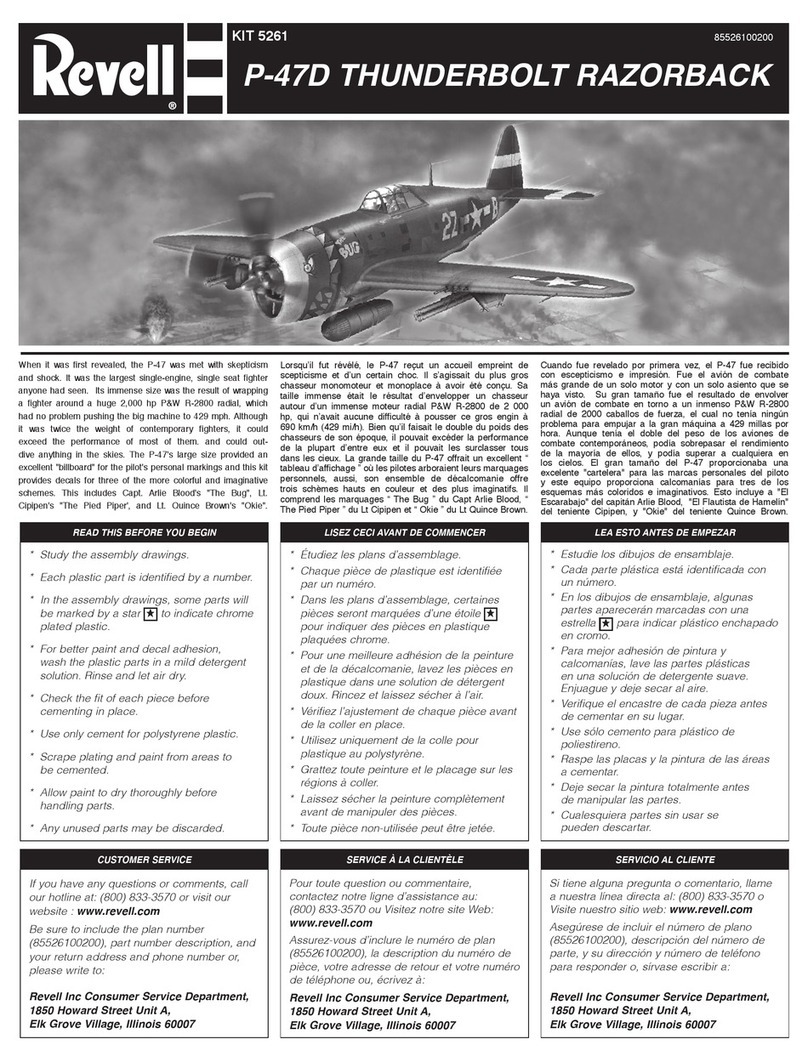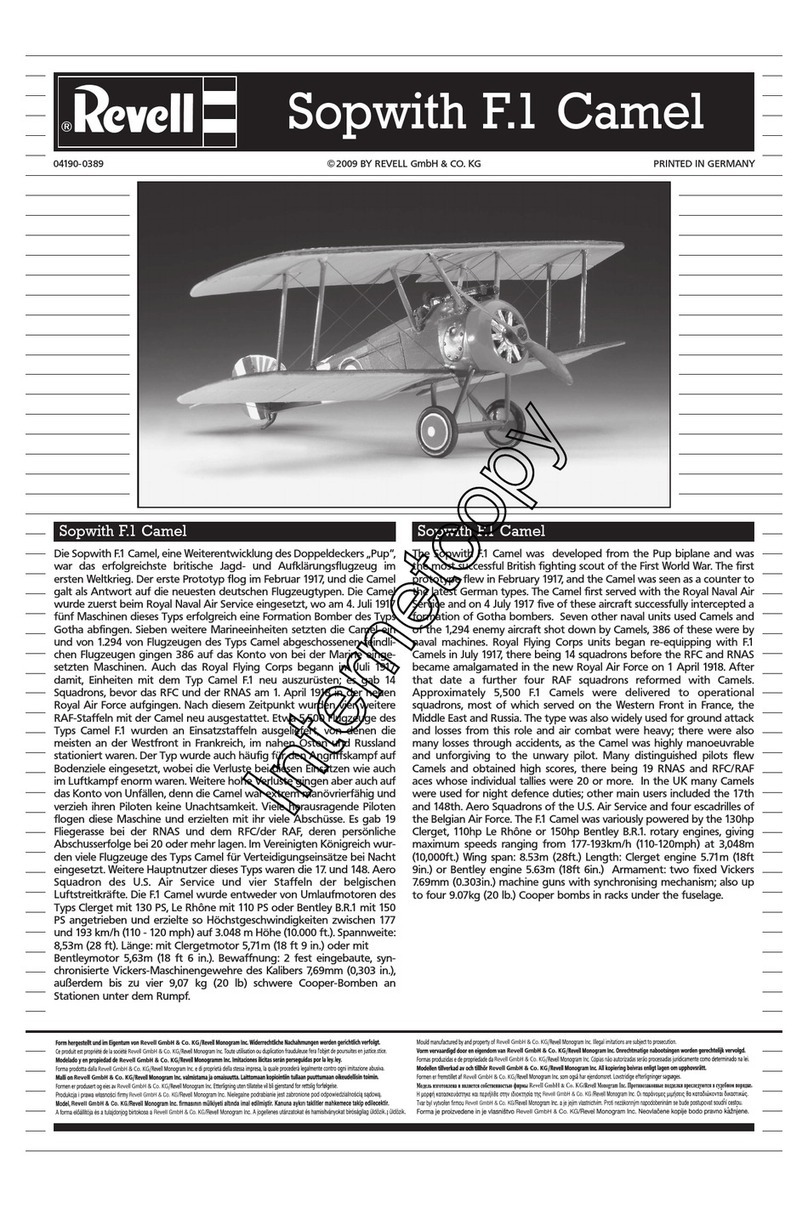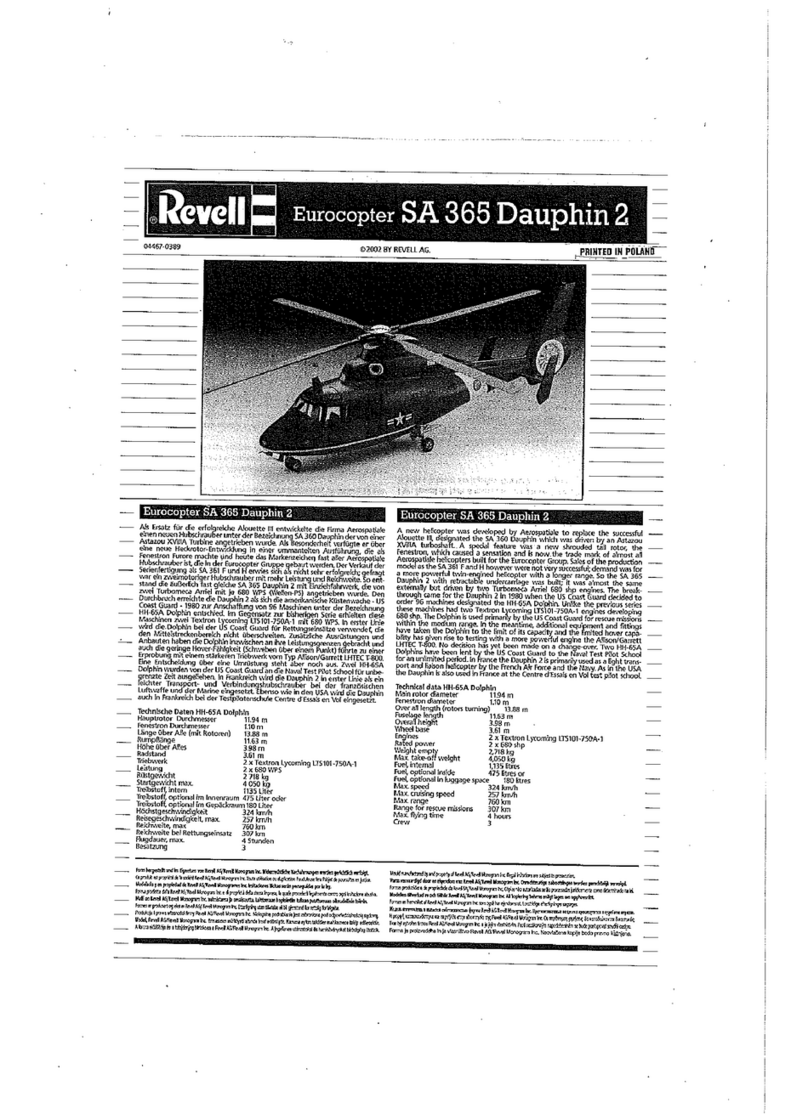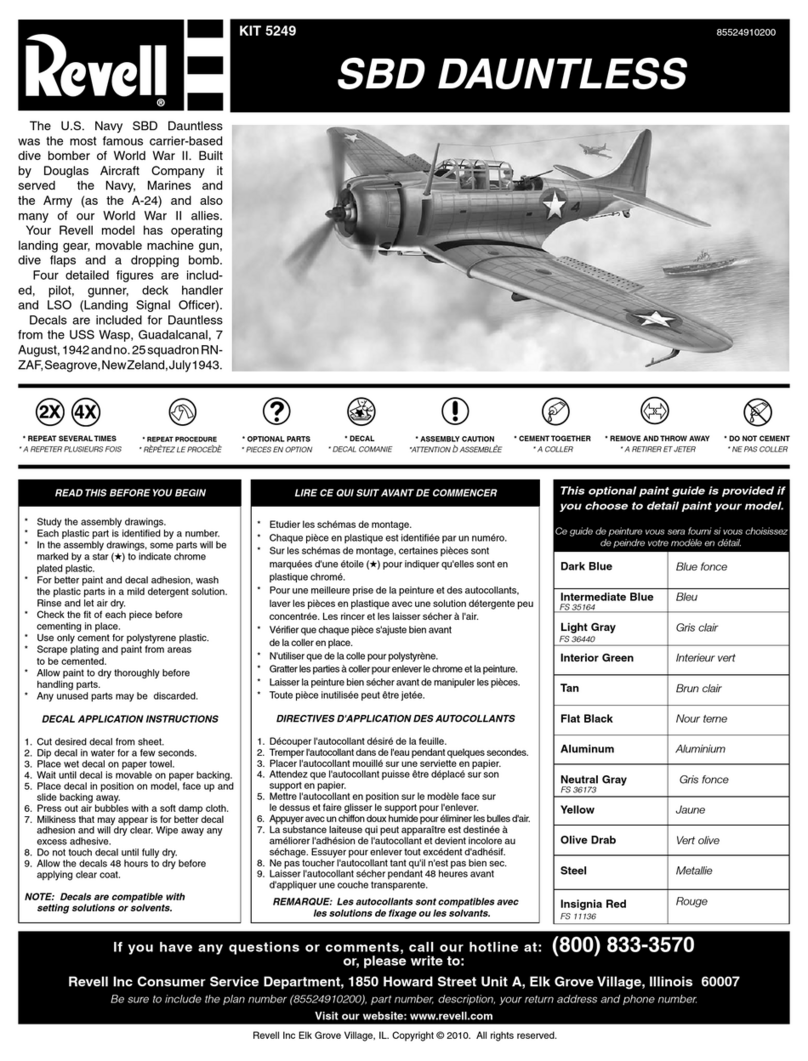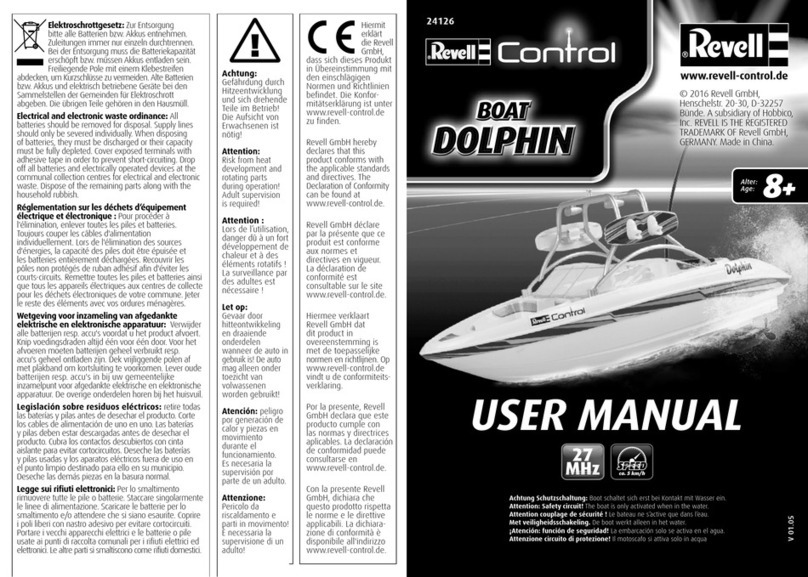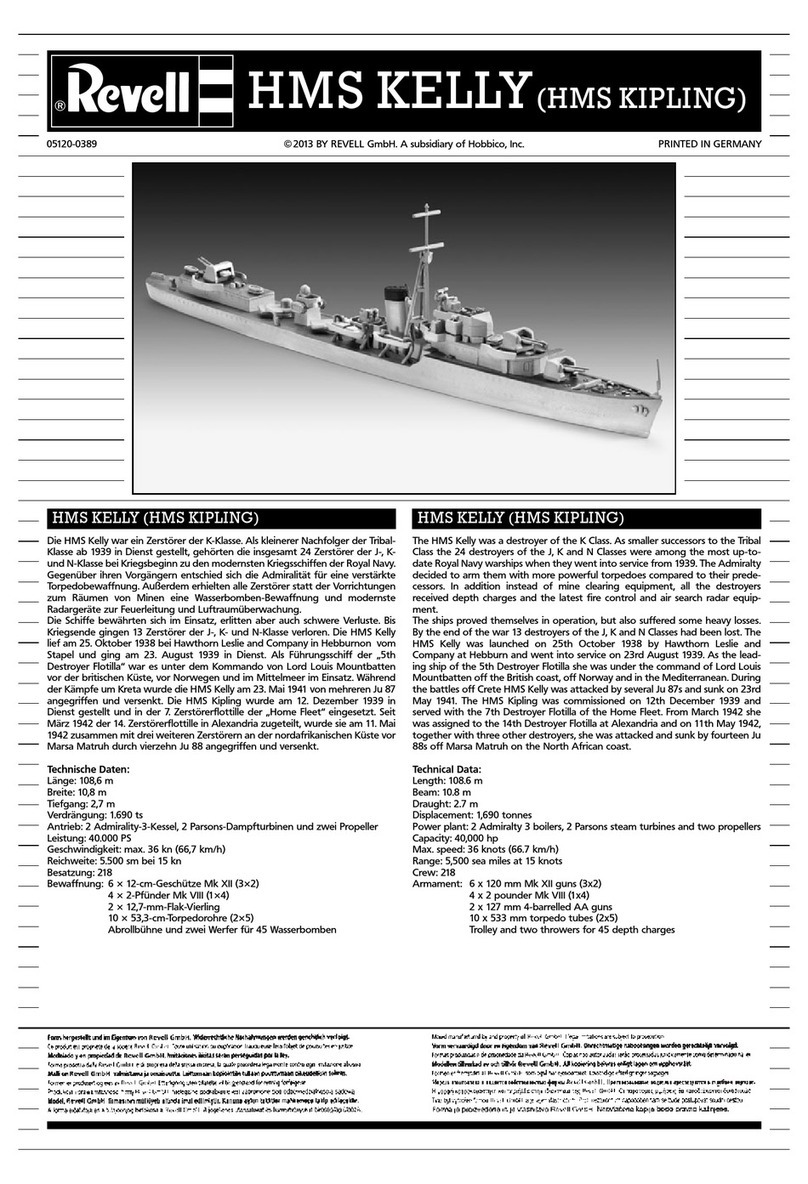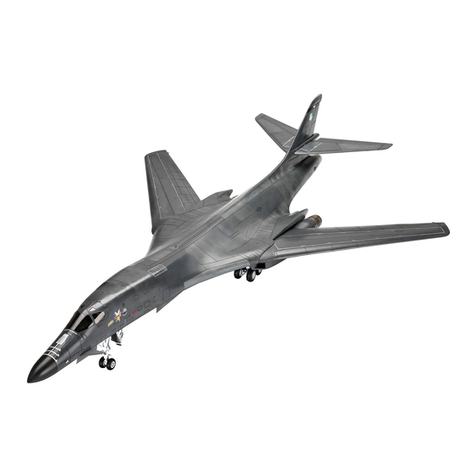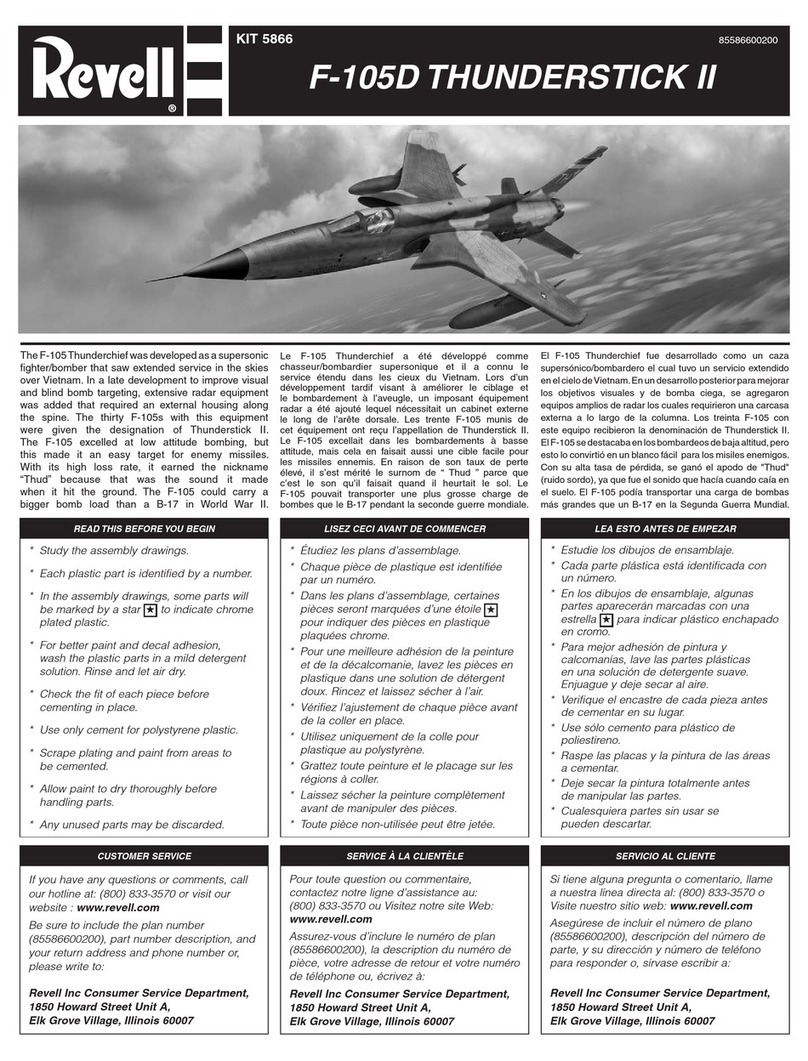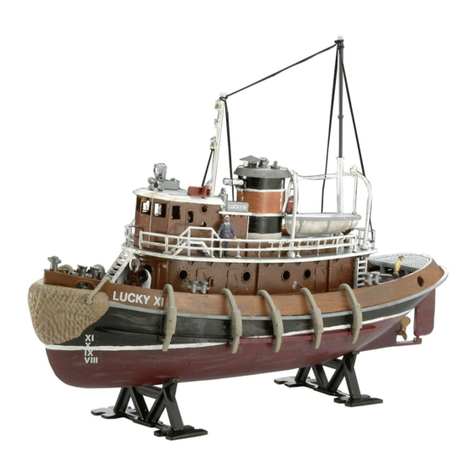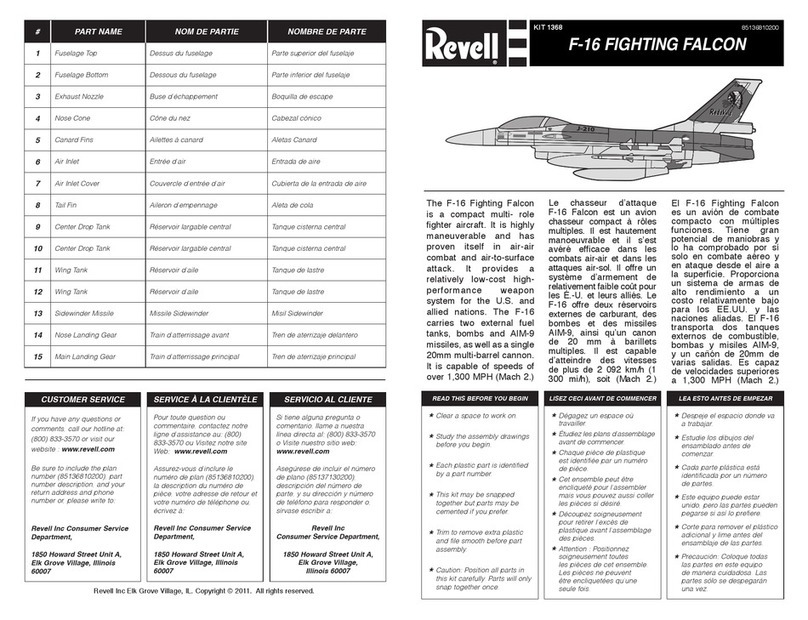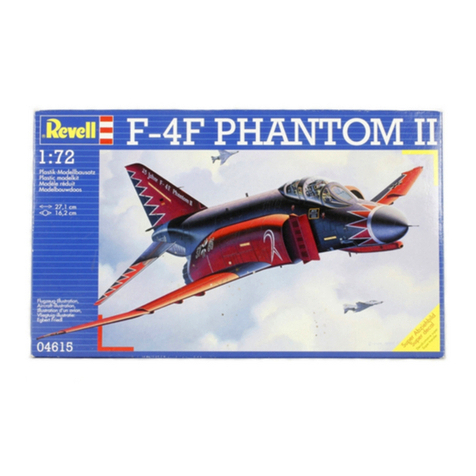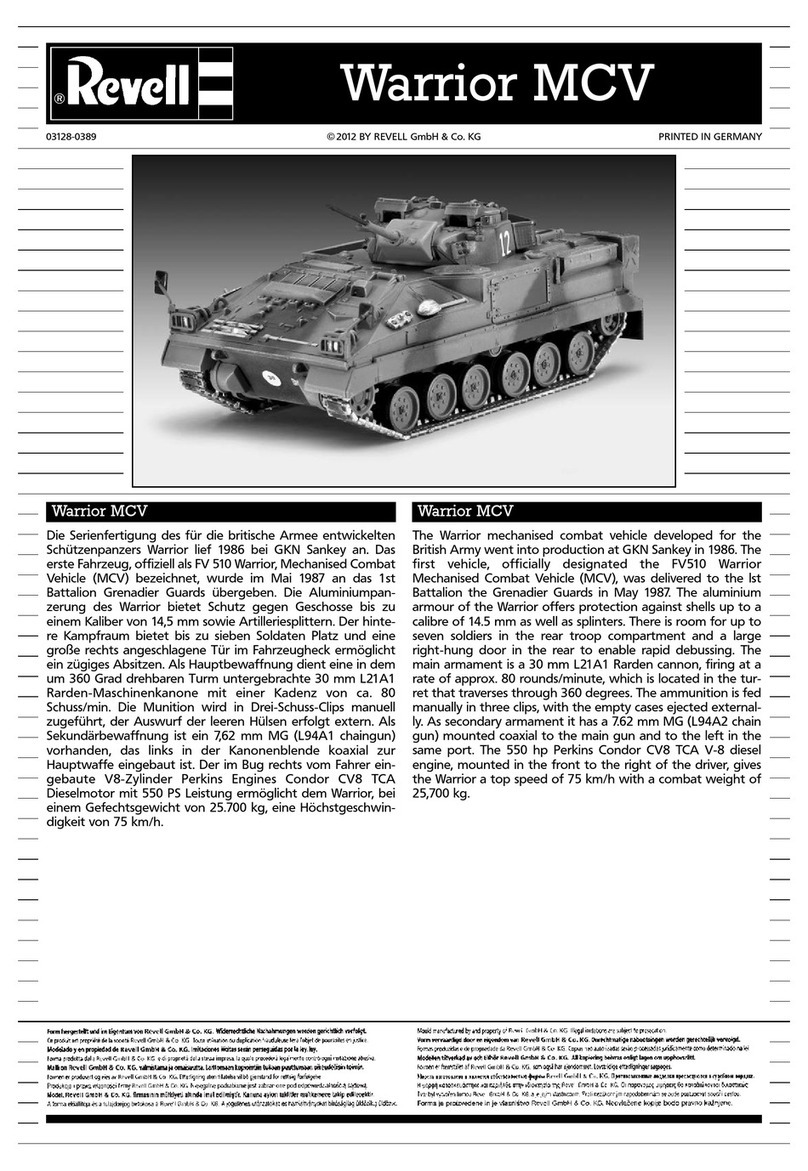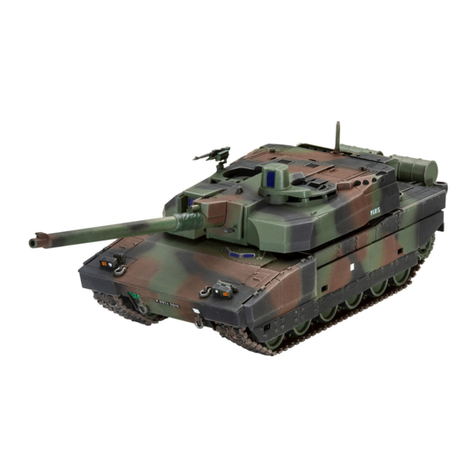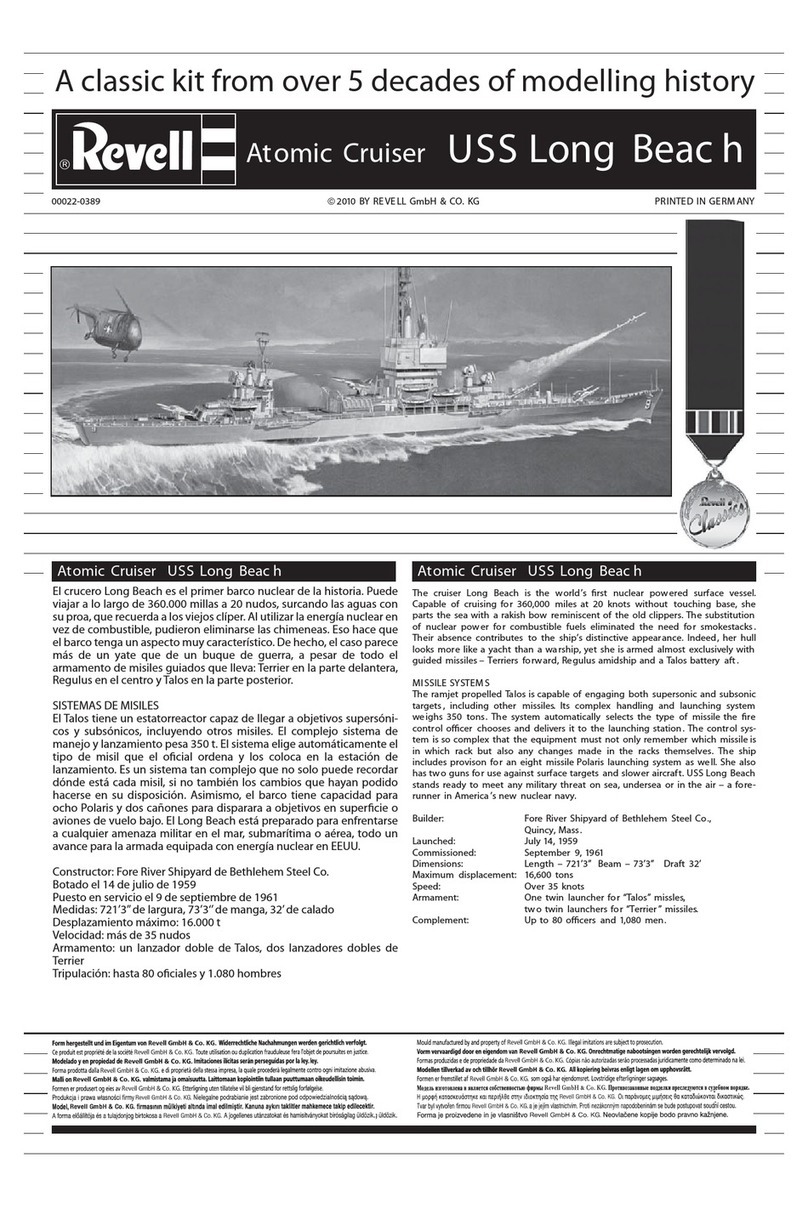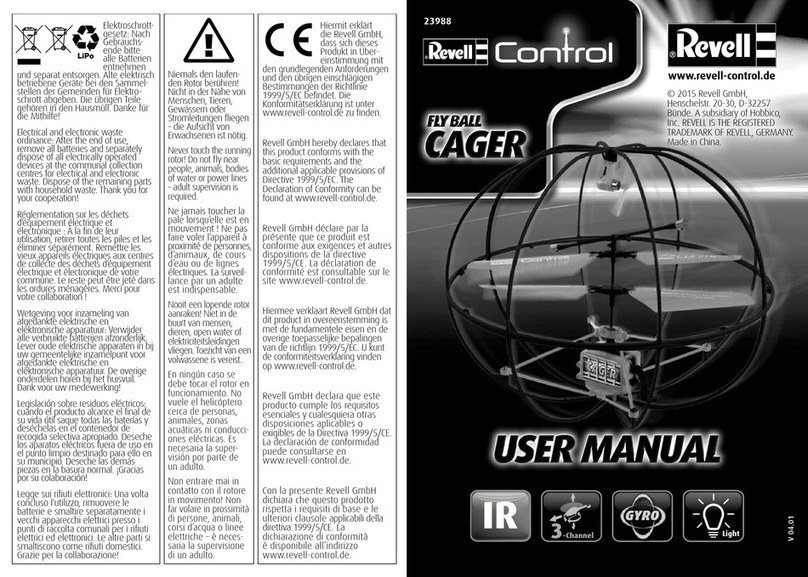Focke Wulf
TL-Jäger „FLITZER“
04191-0389 2008 BY REVELL GmbH & CO. KG PRINTED IN GERMANY
Focke Wulf TL-Jäger „FLITZER“ Focke Wulf TL-Jäger „FLITZER“
In der deutschen Luftfahrtforschung war man 1937 zu der Erkenntnis gelangt, dass der Flugzeug-
antrieb mit Kolbenmotor und Propeller bei einer Höchstgeschwindigkeit von rund 750 km/h an seiner
Entwicklungsgrenze angelangt sein würde. Zu diesem Zeitpunkt produzierte die Flugmotorenindustrie
in Deutschland Triebwerke mit einer maximalen Startleistung von 1100 PS (DB 601 A) und war damit
noch weit von dieser Grenze entfernt. Ernst Heinkel, der bereits 1933 mit seinem Schnellverkehrsflug-
zeug He 70 „Blitz“ neue Maßstäbe gesetzt hatte, erkannte frühzeitig den gegenüber dem Ausland
kurzfristig nicht mehr aufholbaren Rückstand in der Motorenentwicklung Deutschlands. Deshalb för-
derte er bereits seit 1935 alternative Antriebskonzepte wie die Raketenflugzeug-Versuche Wernher v.
Braun´s. Als deren Ergebnis fand der weltweit erste Raketenflug der He 176 mit einem Walter-
Raketentriebwerk HWK RI-203 am 20. Juni 1939 in Peenemünde statt. Die Höchstgeschwindigkeit der
He 176 lag bei 750 km/h. Das verbesserte regelbare Raketentriebwerk HWK RII 211 (HWK 109-509)
wurde ab Juni 1943 in der Me 163 B geflogen. Als nachteilig erwiesen sich der hohe Treibstoffver-
brauch, eine damit verbundene kurze Einsatzdauer und eine unzureichende Produktion der
Treibstoffkomponenten. Der C-Stoff (Wasserstoffsuperoxyd) konnte nur in Aluminiumbehälter gefüllt
werden und reagierte auf geringste Verunreinigungen hochexplosiv. Der T-Stoff, ein Gemisch aus
Methanol, Hydrazinhydrat und Wasser, war stark ätzend und durfte nur in emaillierte Spezialbehälter
gefüllt werden. Die Betankung mit den beiden chemischen Stoffen erforderte deshalb äußerste
Sorgfalt. Vorteilhaft war das geringe Gewicht des Raketenmotors und die enorme Schubleistung von
1500 kp. Die Me 163 B stieg innerhalb von 3 Minuten vom Start weg auf 12 km Höhe.
Ernst Heinkel hat sich als Wegbereiter der Luftstrahltriebwerkstechnik und deren Verwendung im
Flugzeugbau verdient gemacht. Seine Mitarbeiter erzielten die ersten wesentlichen Erfolge. Der
Physiker Dr. Hans-Joachim Pabst v. Ohain entwickelte ab April 1936 im Heinkelwerk Rostock das erste
flugfähige Turbostrahltriebwerk He S 3 B. Als erstes Düsenflugzeug der Welt absolvierte die He 178 mit
diesem Antrieb am 27. August 1939 seinen Erstflug. Daraufhin ergingen vom Reichsluftfahrtministe-
riums (RLM) die ersten konkreten Entwicklungsaufträge an BMW, Junkers und später Daimler-Benz.
Die Entwicklungsarbeit für das operationelle Turbo-Jagdflugzeug He 280 begann 1939. Die He 280 V2
flog erstmals am 30. März 1941 mit zwei He S 8 (je 720 kp Standschub). Im März 1943 mussten diese
Arbeiten zugunsten der Me 262 eingestellt werden. Ernst Heinkel erwarb 1941 die Hirth-Motoren-
werke und intensivierte seine Triebwerksentwicklungen auf breiter Basis. 1944 lief das vielverspre-
chende He S 11 A auf dem Prüfstand und war zur Serienproduktion vorgesehen. Gegenüber dem
BMW 003 und JUMO 004 leistete es mit 1300 kp einen wesentlich höheren Standschub und war für
einen neuen, schnellen Jäger als Nachfolger für die Me 262 bestimmt. An dieser Ausschreibung des
RLM beteiligten sich alle großen deutschen Flugzeugfirmen.
Ab März 1943 entstanden auch bei Focke Wulf in Bremen mehrere Entwürfe einstrahliger TL-Jäger. Mit
dem Projekt P IV konzentrierte man sich auf einen Entwurf, der eine zentrale Rumpfgondel mit zwei
Leitwerkträgern und seitlichen Lufteinläufen am Bug vorsah. Der Gegenentwurf P V war Vorläufer der
Ta 183 „Huckebein“ mit stark pfeilförmigen Flächen. Aus Projekt IV entstand der Entwurf für das
Projekt VI „Flitzer“. Im Februar 1944 wurde ein 1:1 Holzmodell mit Lufteinläufen in den Flügelwurzeln
fertiggestellt und im Windkanal getestet. Als Antrieb sollte das He S 11 A mit einem zusätzlich darun-
ter angeordneten HWK 109-509 C dienen. Der verbesserte Walter-Raketenmotor lieferte 2000 kp
Schub und war vor allem zur schnellen Beschleunigung beim Start gedacht. Die Tragflügel wiesen eine
Pfeilung von 32 Grad auf. Die Treibstofftanks waren im Rumpf, den Flügeln und den Leitwerkträgern
vorgesehen.
Das RLM zeigte an dem Entwurf jedoch kein Interesse. Der Geschwindigkeitszuwachs gegenüber der
Me 262 war zu gering und das He S 11 A war noch nicht verfügbar. Daraufhin stellte Focke Wulf die
Arbeiten an dem Projekt ein.
Technische Daten:
Länge: 10,55 m; Höhe: 2,35 m; Spannweite: 8.0m; Flügelfläche: 14,0 m; Rüstgewicht: 2705kg; Kraftstoff:
570 kg; Walterantrieb mit Treibstoff: 936 kg; Startgewicht: 4767kg; Höchstgeschwindigkeit in 6 km;
Höhe: 830 km/h; Gipfelhöhe: 13 km; Reichweite in 11,5 km Höhe: 570 km; Flugzeit max.: 56 min; Start-
rollstrecke: 400 m; Landegeschwindigkeit: 180 km/h; Triebwerke: Heinkel He S 11 A (1300 kp Stand-
schub) und HWK 109-509 C (regelbar von 400 bis 2000 kp); Bewaffnung: 2 x 30-mm-MK 103 und 2 x
20-mm-MG 151/20.
It was in 1937 when German aviation researchers came to the conclusion that for aircraft using piston
engines and propellers for propulsion, the maximum speed of about 750km/h was the limit of devel-
opment. At this time the German aviation engine industry produced engines with a maximum take-
off performance of 1100hp (DB601A) and was therefore still far away from this limit. Ernst Heinkel who
in 1933 had already set new standards with his Fast Passenger Aircraft, the He70 “Blitz” (Lightning),
soon recognised that engine development in Germany compared with other countries was so far
behind that recovery in the short term was not possible.
This is also the reason that he had since 1935 promoted alternative engine concepts such as the rock-
et powered aircraft of Wernher von Braun. As a result of this, the world’s first rocket powered flight
took place on 20 June 1939 at Peenemünde with the HE176 using a Walter HWK RI-203 Rocket Motor.
The He176 achieved a maximum speed of around 750km/h. An improved and controllable HWK RII 211
(HWK 109-509) Rocket Motor was flown in the Me163B from June 1943. A high fuel consumption and
therefore short flight duration combined with an unavailability of fuel system components proved to
be a considerable drawback.
The C-Substance (Hydrogen Super-peroxide) could only be filled into aluminium containers and react-
ed highly explosively with the slightest impurities. The T-Substance, a mixture of methanol, Hydrazine-
hydrate and water was very corrosive and could only be filled into special enamelled containers.
Refuelling with the both chemical components required therefore extreme care. The light weight of
the rocket motors and an enormous thrust of 1500kp was a great advantage. The Me 163 B climbed
to an altitude of 12,000 metres within 3 minutes from take-off. Ernst Heinkel had made himself a name
as a pathfinder in aviation jet engine technology and its use in the aircraft industry. His coleques
achieved the first noteworthy results. After April 1936 the scientist Dr. Hans-Joachim Pabst von Ohain
developed the He S3B in the Heinkel factory in Rostock. It was the first turbo-jet engine to be used in
an aircraft. On 27 August 1939 the He 178 completed its maiden flight with this engine. It was the first
jet aircraft in the world. Shortly thereafter the first definite development order was dispatched from
the Reichs Aviation Ministry (RLM) to BMW, Junkers and later Daimler-Benz. Development work for the
He 280 operational turbo-jet aircraft began in 1939. The He-280 V2 flew for the first time on 30 March
1941 with two He S 8 engines each of 720 kp static thrust. Work had to be discontinued in March 1943
in favour of the Me 262. Ernst Heinkel acquired the Hirth-Engine Works in 1941 and intensified his
engine development over a wide spectrum. In 1944 the much promised He S 11A ran on a test bed
and was designated as ready for series production. In contrast to the BMW 003 and the JUMO 004 it
produced a considerably higher static thrust with 1300kp and was destined for a new, fast fighter to
succeed the Me 262. All the large German Aircraft Companies took part in this invite to tender from
the RLM. From March 1943 onwards, many designs for a single engine Turbo-Jet Fighter evolved at
Focke-Wulf in Bremen. With project P IV, they concentrated on a design that had a central fuselage
gondola with twin tail-planes and side mounted air intakes in the nose. The opposing design P V was
the fore-runner of the “Huckebein” with highly swept wings.
The design for project VI „Flitzer“ was developed out of project IV. A 1:1 wooden model with air-
intakes in the wing-roots was completed in February 1944 and tested in a wind tunnel. The He S11A
with an additional HWK 109-509C mounted dorsally should serve as power unit. The improved Walter
Rocket Engine produced 2000kp thrust and was thought to be required mainly for fast acceleration
during take-off . The main wing had a sweep of 32 degrees. The fuel tanks were accommodated in
the fuselage, wings and tail structure. The RLM however showed no interest in the design. The increase
in speed compared to the Me 262 was too small and the He S 11A was not yet available. Focke Wulf
stopped work on the project shortly thereafter.
Technical Data:
Length: 10,55 m (34ft 7ins); Height: 2,35 m (7ft 9ins); Wingspan: 8.0 m (26ft 3ins); Wing Area: 14,0 sq.m
( 150sq.ft); Operational Weight: 2705 kg (5965lbs); Fuel: 570 kg (1257lbs); Walter Engine with Propellant:
936 kg (2064lbs); Take-off Weight: 4767 kg (10510lbs); Maximum Speed at 6000m Altitude: 830 km/h
(515mph); Service Ceiling: 13,000m (42640ft); Range at 11500m Altitude: 570 km (355miles); Duration
Maximum: 56 min; Take-off Run: 400 m 1312ft); Landing Speed: 180 km/h (112mph); Power Units:
Heinkel He S 11 A (1300 kp Static Thrust) and HWK 109-509 C (variable from 400 to 2000 kp);
Armament: 2 x 30mm MK 103 and 2 x 20mm MG 151/20.
